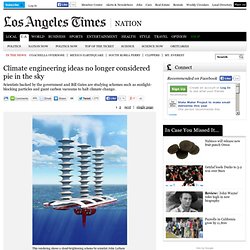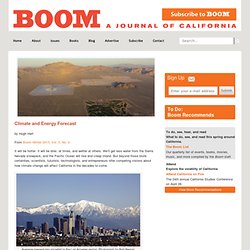

Acidification fight faces political hurdles. While states like Washington are moving on their own to curb ocean acidification, national efforts are stymied by politics — and ever-rising CO2 emissions.

When U.S. Rep. Brian Baird tried a few years ago to get his colleagues to put more money toward ocean-acidification research, few even understood the issue. One congressman, Baird said, confused souring seas with acid rain, and asked, “Didn’t we deal with that 20 years ago?” The corrosion of the oceans by carbon-dioxide emissions has barely made a ripple among Washington, D.C.’s power brokers.
In fact, aside from West Coast lawmakers and scattered others from coastal regions, few in Congress seem to grasp the scale of the challenge, said current and retired lawmakers from both parties. So West Coast states, led by Washington, are now forging ahead largely on their own. “This is a profound and unprecedented threat,” said Baird, a Washington Democrat, who stepped down in 2011 and is now president of Antioch University in Seattle.
2013 Global Ocean Acidification Observing Network Workshop. Crime rates could rise as climate change bites - environment - 28 February 2014. In a warmer world it might be best not to leave your windows open.

As temperatures rise, so do crime rates, suggesting climate change will lead to millions of extra offences in the coming decades. However, factors such as better policing may keep a lid on the problem. The link between temperature and crime has been researched for years, and criminologists agree that warm days see more offences. Nobody is sure why. Snow and closed windows in colder weather may deter some crimes, while warmer weather may increase social interaction and thus the likelihood of some offences. In theory, climate change should make this worse. Ranson then used a mathematical model to predict how climate change would affect crime rates in each county, using his crime-temperature relationships and the average daily maximum temperature changes predicted by 15 climate models.
The model predicts relatively small increases in crime rates, of 0.5 to 3.1 per cent depending on the type of crime. Fever pitch. Ancient "Giant Virus" Revived From Siberian Permafrost. Buried deep in the Siberian permafrost and untouched for over 30,000 years, researchers have discovered what is thought to be the newest representative of what are loosely known as "giant viruses. " A team led by Jean-Michel Claverie and Chantal Abergel of Aix-Marseille University in Marseille, France, made the discovery of the previously unknown virus, which has been dubbed Pithovirus sibericum and can be revived in the lab. Their findings are detailed in a new article in the Proceedings of the National Academy of Sciences.
Lest Siberian excavation makes you think of frozen woolly mammoths, make no mistake: These giants are still decidedly microscopic. Risks from climate feedbacks POSTnote. Climate engineering ideas no longer considered pie in the sky. WASHINGTON — As international efforts to reduce greenhouse gas emissions stall, schemes to slow global warming using fantastical technologies once dismissed as a sideshow are getting serious consideration in Washington.

Ships that spew salt into the air to block sunlight. Mirrored satellites designed to bounce solar rays back into space. Massive "reverse" power plants that would suck carbon from the atmosphere. These are among the ideas the National Academy of Sciences has charged a panel of some of the nation's top climate thinkers to investigate. Several agencies requested the inquiry, including the CIA.
At the Jet Propulsion Laboratory in La Cañada Flintridge, scientists are modeling what such technologies might do to weather patterns. Even as the research moves forward, many scientists and government officials worry about the risks of massive climate-control contraptions. Some fear the potential for error in tampering with the world's thermostat. Geo-engineering could make climate worse, study says. Climate and Energy Forecast « Boom: A Journal of California. By Hugh Hart From Boom Winter 2013, Vol. 3, No. 4 It will be hotter.

It will be drier, at times, and wetter at others. We’ll get less water from the Sierra Nevada snowpack, and the Pacific Ocean will rise and creep inland. But beyond those brute certainties, scientists, futurists, technologists, and entrepreneurs offer competing visions about how climate change will affect California in the decades to come. Average present-day snowfall in the Los Angeles region. “The choice before us is not to stop climate change,” says Jonathan Parfrey, executive director of Climate Resolve in Los Angeles.
So what will it be? The bad news. If we choose to do nothing, the nightmare scenario plays out something like this: amid prolonged drought conditions, wildfires continuously burn across a dust-dry landscape, while potable water has become such a precious commodity that watering plants is a luxury only residents of elite, gated communities can afford. The sea level will rise along the coast.